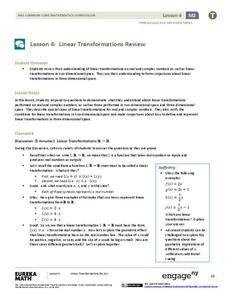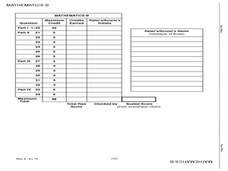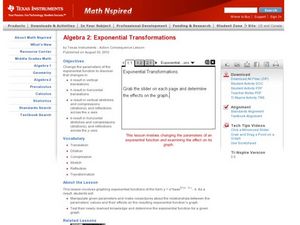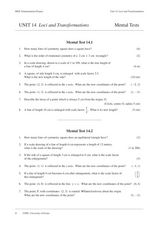EngageNY
Composition of Linear Transformations 2
Scholars take transformations from the second to the third dimension as they extend their thinking of transformations to include three-dimensional figures. They explore how to use matrices to represent compositions of...
EngageNY
Linear Transformations Review
Time for matrices and complex numbers to come together. Individuals use matrices to add and multiply complex numbers by a scalar. The instructional activity makes a strong connection between the operations and graphical transformations.
EngageNY
Transformations of the Quadratic Parent Function
Efficiently graph a quadratic function using transformations! Pupils graph quadratic equations by completing the square to determine the transformations. They locate the vertex and determine more points from a stretch or shrink and...
Curated OER
Twists and Turns
Pupils reflect, rotate, translate, and dilate figures in the Cartesian coordinate plane using grid paper and dot paper. They use transformations (i.e., reflections, translations, rotations, and dilations) to describe geometric patterns...
Curated OER
Transformations on the Coordinate Plane
Here is a study guide on transformations that includes reflections, translations, dilations, and rotations. It also has definitions, helpful diagrams, and several examples involving transformations on the coordinate plane. The lesson...
Curated OER
Transformations
In this transformations worksheet, pupils draw the transformations of the triangles and parallelograms in graphs. They complete four drawings.
Curated OER
Design Explorations: Frieze Patterns
Pupils will explore frieze patterns. A frieze pattern is a mathematical concept to classify designs on two-dimensional surfaces, which are repetitive in one direction, based on the symmetries in the pattern. They will explore examples of...
Curated OER
Similar Figures
For this similar figures worksheet, students identify the meaning of similar, corresponding sides, and congruent. They use proportions to find the length of a missing side. Students dilate given figures according to a scale...
EngageNY
Are All Parabolas Similar?
Congruence and similarity apply to functions as well as polygons. Learners examine the effects of transformations on the shape of parabolas. They determine the transformation(s) that produce similar and congruent functions.
EngageNY
The Angle-Angle (AA) Criterion for Two Triangles to Be Similar
What do you need to prove triangles are similar? Learners answer this question through a construction exploration. Once they establish the criteria, they use the congruence and proportionality properties of similar objects to find...
Curated OER
Triangles
In this triangles worksheet, 10th graders solve and graph 8 different problems that include various transformations. First, they write a rule for the composition of a dilation of a scale factor. Then, students determine whether a graphed...
Curated OER
Transformations Using Matrices
In this transformations worksheet, 10th graders solve and complete 16 different types of problems. First, they graph the image of the figure using the transformation given. Then, students find the coordinates of the vertices of each...
Curated OER
High School Examination: Mathematics B
In this high school examination worksheet, 12th graders solve problems dealing with parabolas, coordinates, probability, dialations, intervals, and trignomeric ratios. This worksheet is designed as a end of course...
Curated OER
Dilations of 2 and 3 dimentional figures and their effect on area, surface area, and volume.
Seventh graders investigate the area and volume of 2D and 3D figures. In this geometry lesson, 7th graders create a storyboard explaining their knowledge of 2D and 3D shapes. They analyze their data and interpret their...
Curated OER
Black Holes...III
In this black holes worksheet, learners use a formula for time dilation which causes delays in events that occur near the black hole. They solve 6 problems using the equation.
Curated OER
Similar Figures
In this geometry worksheet students explore similar polygons and determine measure of missing sides and angles. Students use indirect measurement with similar triangles and determine the area and volume of similar figures. The seven...
Curated OER
Equation of a Circle
High schoolers write the equation of a circle. In this geometry lesson, students check the solution of a coordinate pair by evaluating them. They graph the circle given the equation and radius.
Curated OER
New York State Standards
In this math activity, students review for the high school exit exam of New York. They solve problems using algebra, geometry, and precalculus. There are 30 questions.
Curated OER
Scale Factor Area Perimeter
Mathematicians compare triangles at different scales. In this geometry lesson, students calculate the area and perimeter of triangles. They use the Ti to make observation of the change that takes place as the triangles are dilated.
Curated OER
Exponential Transformations
Perform transformations on exponential functions! Teach your class how to perform dilation, compression, and translation. They graph exponential functions using the TI Calculator.
Curated OER
A Geometry Worksheet - Similar Triangles
In this similar triangles worksheet, high schoolers find the scale factor of 6 sets of similar triangles. Students find the scale factor of two similar triangles given a sketch with measurements. High schoolers use proportions to find a...
Curated OER
Black Hole...Fade-out!
In this black hole worksheet, students read about how images fade to black when they reach an event horizon of a black hole. Students solve 3 problems about black holes using a given equation for luminosity. They find the time it takes...
Curated OER
Unit 14 - Loci and Transformations
In this transformations worksheet, learners solve 25 short answer problems. Students dilate, reflect, and translate points and figures in the coordinate plane. Learners determine scale factors and lines of symmetry of figures.
Curated OER
Geometric Transformations
Learners examine images and preimages of a mapping and identify isometry. They view images by M.C. Escher, observe teacher demonstrations, and create a translation image, a rotation image, and a dilation.

























